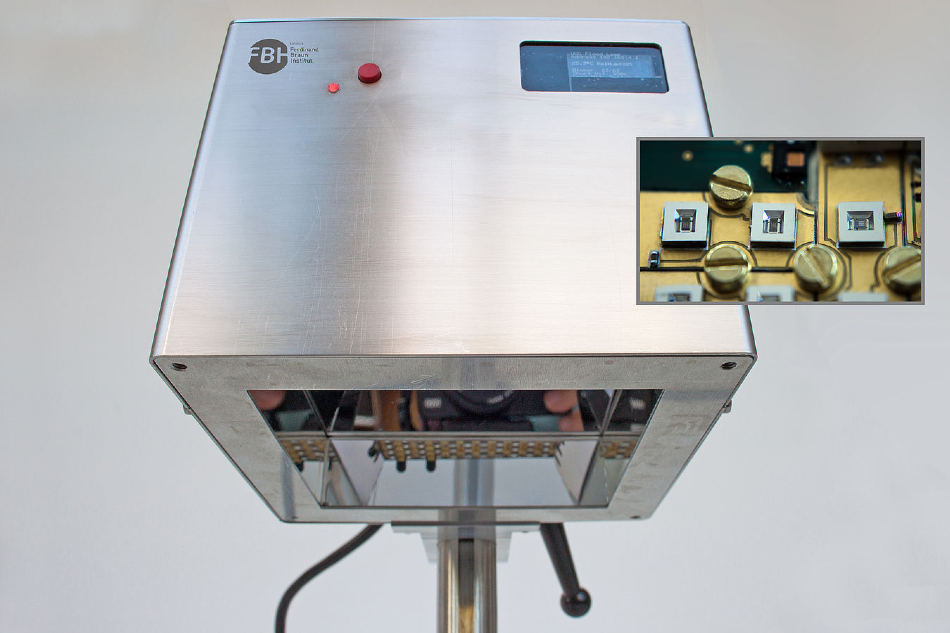May 26 2020
The Robert Koch Institute reports that every year, Germany experiences 400,000 to 600,000 infections that are caused by hospital germs and lead to the death of approximately 10,000 to 20,000 people.
 Prototype of the UVC LED irradiation system with 118 LEDs—with it germs on the skin are supposed to be killed. The inset shows a detail of the LED array. Image Credit: FBH/P. Immerz.
Prototype of the UVC LED irradiation system with 118 LEDs—with it germs on the skin are supposed to be killed. The inset shows a detail of the LED array. Image Credit: FBH/P. Immerz.
There is a need for alternative methods because multidrug-resistant (MDR) microorganisms cannot be usually treated with antibiotics. Irradiation with UVC light offers a potential physical principle, which can be used to kill the pathogens without enabling them to build up their resistances.
Within the context of their Joint Lab GaN Optoelectronics, Technische Universität Berlin (TUB) and the Ferdinand-Braun-Institut (FBH) have created LEDs that emit in the far ultraviolet (UV) spectral range. Emitting at wavelengths of about 230 nm, these LEDs offer over 1 mW of output power.
But due to technological limitations of the utilized material system—aluminum-gallium nitride (AlGaN)—these UVC LEDs are yet to become commercially available across the world. Their light does not enter into the skin’s living layers due to their high degree of absorption.
Hence, it is anticipated that the skin—contrary to the long-wave UVC radiation produced by mercury vapor lamps, for instance—will never be harmed or, at the most, it will be damaged so mildly that the effect will be compensated by the natural repair mechanisms.
The scientists believe that this method will help destroy the MDR microorganisms without causing any long-term side effects.
Within the context of the VIMRE project—called prevention of infection with multidrug-resistant pathogens via in-vivo UVC irradiation—FBH has devised and created a new irradiation system that contains an array of 118 of these LEDs on an 8 cm x 8 cm area.
The system achieves the highest irradiation power of 0.2 mW/cm2 with uniformity of over 90% across a 6 cm x 6 cm area. The initial prototype was sent to the Department of Dermatology at Charité–Universitätsmedizin Berlin for skin analyses.
The Institute for Hygiene and Environmental Medicine of the University Medicine Center Greifswald will shortly receive another device to shed light on the microbicidal effectiveness. The German Federal Ministry of Education and Research (BMBF) is financially supporting the VIMRE project as part of the consortium “Advanced UV for Life” within the Twenty20 program.
Prototypes Aimed to Validate Procedures
Tests performed by both partners with the help of these devices are meant to demonstrate that UVC irradiation is appropriate for destroying pathogens and specifically MDR microorganisms (eradication). The aim is also to demonstrate that this kind of exposure will not harm the humans as long as certain irradiation doses are upheld.
This will be validated using tissue samples of human skin and also using mucosa and skin models, because the pharynx and the anterior nasal cavity happen to be the desired habitat of the pathogens, like MDR microorganisms.
For this reason, the Charité performed dose-dependent analyses of potential DNA damage caused to the irradiated skin. The University Medicine Center Greifswald will ascertain the effectiveness of the UV LED emitters in destroying the MDR microorganisms at 230 nm and evaluate the outcomes against those of the UV lamps with emission at 222 and 254 nm.
Miniaturization and Further Applications—an Outlook
LEDs offer several benefits and open up more perspectives—they are specifically compact and thus enable miniaturized irradiation systems. These LEDs could be employed as hand-held devices or used endoscopically in body orifices.
In addition, they produce only a minimal amount of heat and seldom place any strain on the skin. The LEDs also eliminate the need for high voltage—a significant safety aspect because they are applied to humans as well.
In the days to come, the UV LED irradiation system needs to be further improved so that microorganisms can be removed from difficult-to-access places.
Since the device can be deactivated by short-wave UVC light, they may even prove fascinating for coronaviruses. Considering that SARS-CoV-2 duplicates in the pharynx in the first phase, it appears reasonable to use these kinds of light sources in this part of the body to prevent COVID-19 infections.